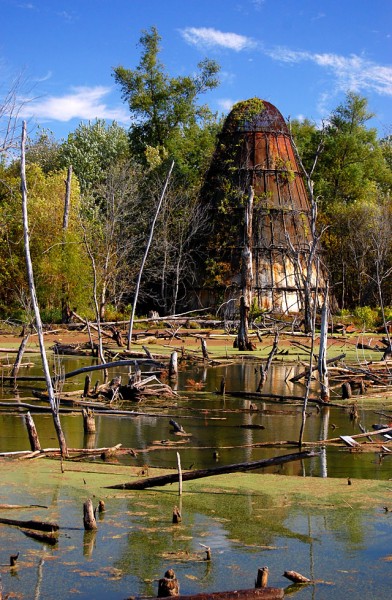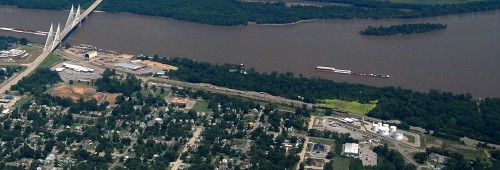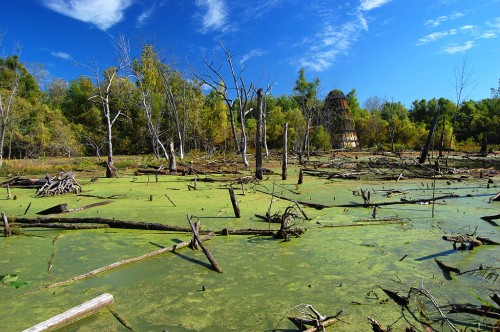 Mother and I took a cruise down to South Cape to see if Sprigg Street is open where the sinkholes closed the road near the Cape LaCroix bridge during the spring flood. (It isn’t.)
Mother and I took a cruise down to South Cape to see if Sprigg Street is open where the sinkholes closed the road near the Cape LaCroix bridge during the spring flood. (It isn’t.)
A roundish, triangular-shaped structure caught my eye to the east of Giboney Street, right around where the railyards are. I thought it might have been a kiln of some kind, but a quick call to Keith Robinson, who knows everything there is to know about anything that comes close to a railroad track, came up with the answer. (Click on any photo to make it larger.)
It’s a sawdust burner
The object was a sawdust burner, left over from the days when M.E. Leming Lumber occupied a good part of that stretch of the river. The river was a good thing and a bad thing for the lumber company. It provided a convenient way to ship trees and finished lumber to and from the mill, but it also meant that it was susceptible to Mississippi River floods.
“The river put us out of business,” Missourian associate edtor Ray Owen quoted Howard C. Tooke, president of the company from 1956 until it closed in 1992. Tooke said in the Feb. 28, 1993, story that “In 1973, we had a major flood. Over the next three years, we had seven floods. It got to the point where we were running only about eight months a year.” Ironically, the company closed before the big flood of 1993 that pretty much marked the end of Smelterville and the Red Star District.
Swamp replaced busy lumber yard
 The Missourian story has an excellent photo taken during the company’s heyday in 1939 showing the area covered in stacks of lumber. This aerial, taken from a Cape Air Flight this summer, shows the area today. The light green patch across from the passing barge is where the sawdust burner is located. Most of the wooded area around the green swamp was once the lumber yard.
The Missourian story has an excellent photo taken during the company’s heyday in 1939 showing the area covered in stacks of lumber. This aerial, taken from a Cape Air Flight this summer, shows the area today. The light green patch across from the passing barge is where the sawdust burner is located. Most of the wooded area around the green swamp was once the lumber yard.
Directly south of the Bill Emerson Memorial Bridge is the Missouri Dry Dock. The orange, cleared land to the west of it is the space that folks were speculating might become a minor league baseball field.
Leming Lumber founded in 1893
 The company, founded in 1893, was one of Cape’s largest employers for many years. Today, about all that’s left is this sawdust burner. A peek at Google Earth shows what might be a few foundations scattered around, but I won’t check those out until a trip when it’s been cold enough to kill all the vegetation, cause the ground to get hard and to send the ticks, chiggers and snakes into hiding.
The company, founded in 1893, was one of Cape’s largest employers for many years. Today, about all that’s left is this sawdust burner. A peek at Google Earth shows what might be a few foundations scattered around, but I won’t check those out until a trip when it’s been cold enough to kill all the vegetation, cause the ground to get hard and to send the ticks, chiggers and snakes into hiding.

Two posts in one day…are you bucking for a raise?
My Mom worked for Mayor Tooke & his wife, wonderful people. Mom wasn’t just an employee they made her part of the family & their grands called her Park. Great memories of picking apples from their tree & receiving hand made ornaments Mrs. Tooke made. One of the most memorable cards on their floral memorial, was signed simply said “Goodbye Park”. They are both deceased now too, I never travel Bloomfield that I don’t look at their corner…miss the tree, the house (burned twice after sold),miss the Tookes & most of all I miss my Mom, “Park”! Great memories of one of Cape’s finest mayors, & an all around fine man, Mayor Howard Tooke.
So, can you get to the South Sprigg Street area via another route? I was hoping to visit the old neighborhood someday. And I did not know that the Red Star district had been destroyed. My grandfather, James Johnson, owned a home there in his later years. Many times we saw the water just shy of his front porch. I went to the Red Star Baptist church when I was a little girl. I was a ‘Sunbeam’. 🙂
You can get as far as Cape LaCroix Creek going south out of Cape. To get to the cement company, you have to come in from the south side. The road is out at the creek.
Here are photos of the sinkholes.
ken, in the area that you point out, there were, at one time, two lumber companies operating.
The M.E. Leming Company is well known by most Cape natives, but the Garvey Lumber Company is less well known. The Leming Lumber Company covered the greatest amount of area and received most of the logs they cut via floating rafts of logs floated down the river. Cut lumber was shipped via the railroad or by barges on the river. In an aerial picture of M.E. Leming looking east, sluices can be seen that
The Garvey Lumber Company was the other company, located to the south end of the treed area in the photo above. Garvey soley received logs and shipped cut lumber via the local railroad.
Two other Leming icons stil remain in Cape. The most obvious is the house on North St. Less visible is Mr. Leming’s 1955ish maroon and tan Chrysler Imperial said to be stored in a barn on Windy Hill.
They called them beehive burners. I have photographed several of them as I did my genealogy treks to lumberyards where McKeowns worked. Very often, the burners would be the only thing left standing.
I’ve wandered all through the woods behind the old burner, and there’s still a ton of old buildings and conveyors. Lots of interesting, and possibly unsafe urban hiking back there!
I was born between the ME Lemong saw mills.right south of Missouri dry docks. we carried our drinking water from the mill .we got free wood to thwere was a treain yard there and the boats went up and down the river. the lower mill ended at the levee. then there was the old stave mills foundzatins and when you crossed a little creek yoju were in Smelterville.
we had a nice house down by the river.
My Grandfather was a night guard at Lemming Lumber for many years. I have very fond memories of taking his evening meal to him from my grandparents house on Gibney St. I fell asleep many night on a pile of sawdust. Different times and diferent attitudes. Take Care.